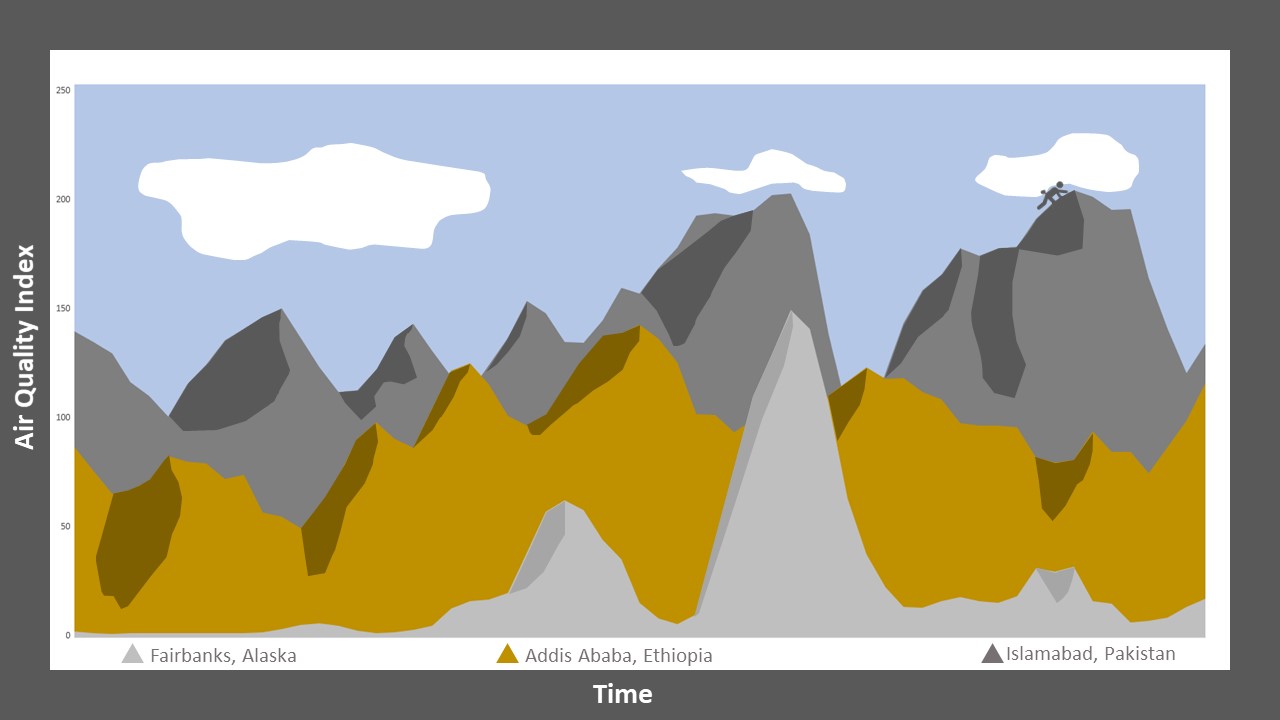
PM 2.5 is fine inhalable particulate matter less than 2.5 µm in diameter (about 1/30th the width of a human hair). Fairbanks has serious problems with PM 2.5; levels often exceed the standard set by the EPA. Many epidemiological studies show a strong correlation between exposure to PM 2.5 and increased morbidity, not just from respiratory complications, but mainly due to cardiovascular diseases. This is because the smallest of the ultrafine particles in PM 2.5 can diffuse from the alveoli of the lungs across the respiratory membrane and into the systemic circulation of the body.
My art piece explores the interaction of the cardiovascular and respiratory systems as it relates to inhalation of PM 2.5. To make the image, I searched for historical AQI for three cities I have lived in over the last decade: Addis Ababa, Ethiopia; Islamabad, Pakistan; and Fairbanks, Alaska. I downloaded data from sensors in each location over a two month period. I then stacked the data for each location in an area chart over a sixty day period, exported the graph as an image, and edited the image to make the illustration. The silhouette of the climber in the far right represents me tackling health challenges I may face in the future as a result of long term cumulative exposure to high levels of PM 2.5.

When I see addis I think of Abebe Bikila running barefoot. Cool and relevant project
Thanks! It was fun to use real data for the project. When I lived in Addis (~10 yrs ago) I ran quite a bit (much slower than an Ethiopian marathoner!) and developed a chronic upper respiratory infection that lasted almost a year. I’ve been much more aware of air pollution since then. I shudder to think what all the PM may have also done to my cardiovascular system.
pretty cool!
To be honest I had no idea what PM2.5 was before Anna’s project. PM2.5 is air pollutant so microscopic, it can pass through the alveoli and into the blood stream. This pollutant is from wood burning, vehicle exhaust and wildfires. Fairbanks has a problem with unhealthy Air Quality Index readings, which include pollutants like PM2.5 year-round. PM2.5 has been linked to increased morbidity risk due to cardiovascular diseases. These health risks are long lasting, even after someone is reintroduced to clean air. Health conditions vary depending on existing conditions but include increased risk to heart attack or stroke.
Ways to protect yourself from PM2.5 is to wear a mask outdoors (especially during low quality air advisories), stay healthy and fit, stay well rested, install air purifiers, and keep your doors and windows closed, while continuing to clean regularly.
Anna’s art portrays the last three places she has called home and compared their air quality over the past few months. Using this data, she crafted mountains to climb as she takes preventative measures against air pollutants. Staying fit and active is the best preventative measure for cardiovascular diseases, especially when pollutants are involved.